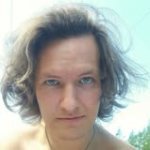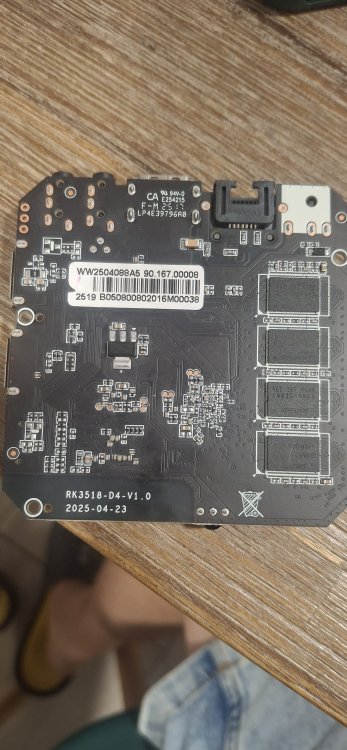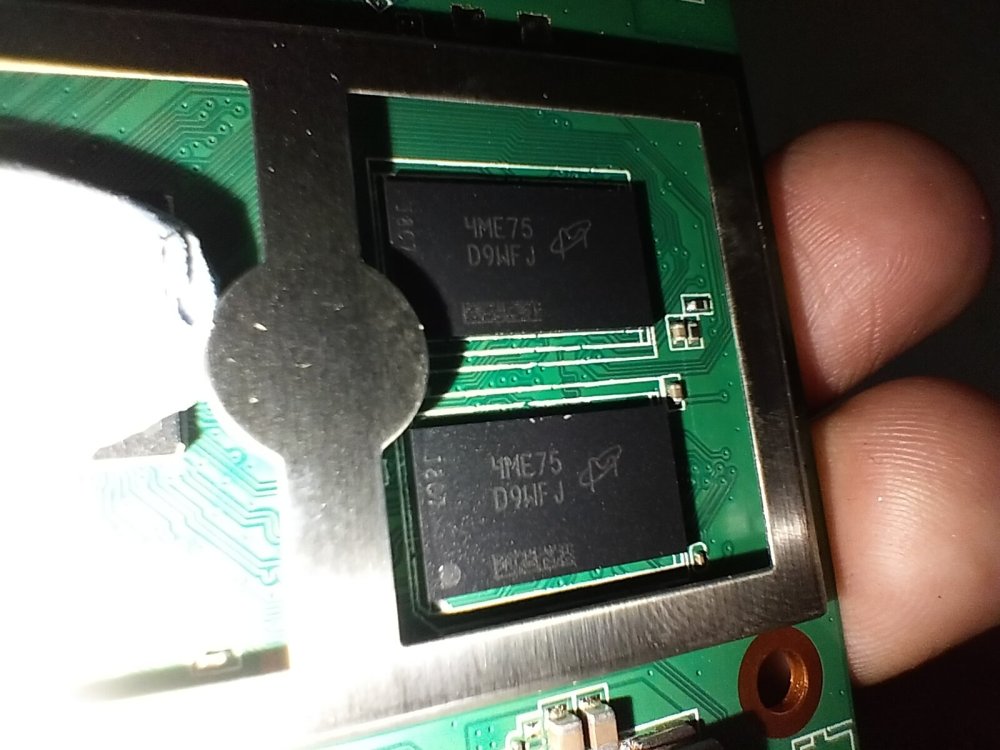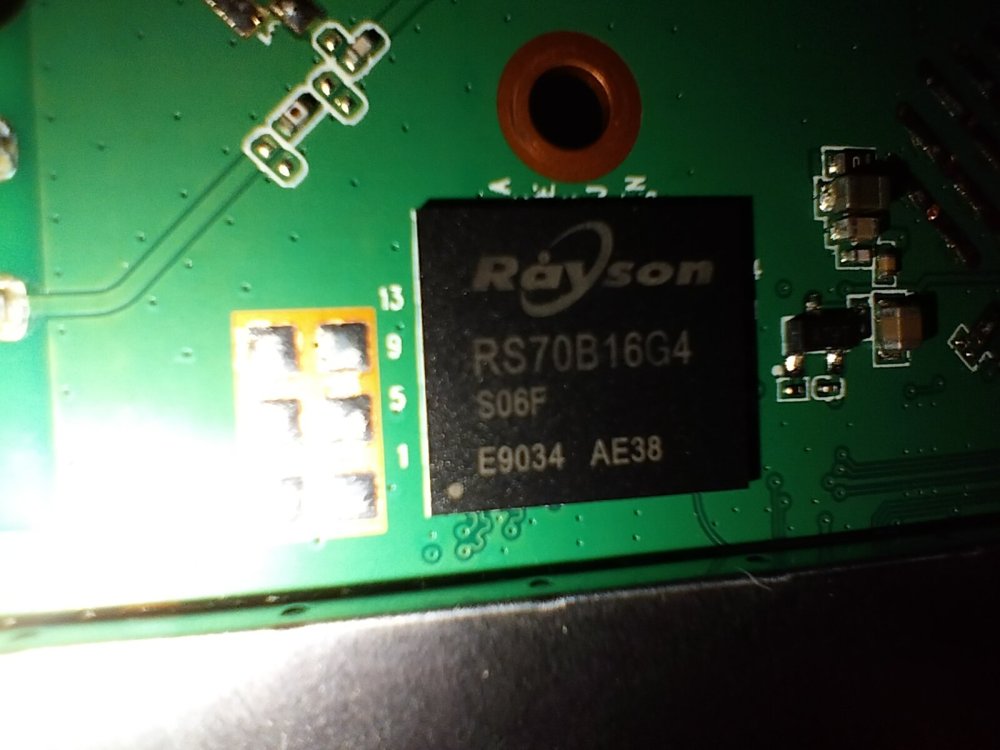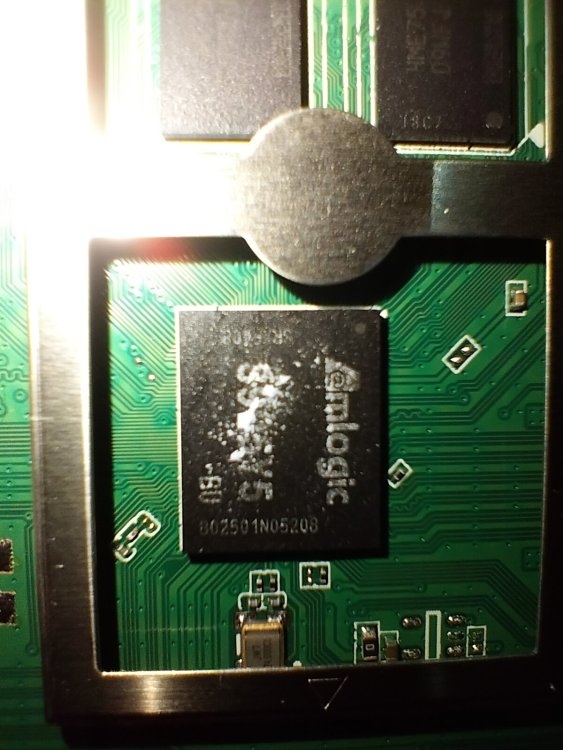Search the Community
Showing results for 'youtube'.
-
Hy all, For some time now I have a Rock 5b + with 16Gig memory. The problem I have is playback video' s in youtube. Video's are not even watcheble in the lowest resolution. Other 4k video' s play fine. I tried several bechmark video' s from online sources. I looked around to see if others experiance the same problem but cannot find anny clu in this matter. I use Armbian ver. 25.5.1 Do others have the same issue? Is there a soltion for this problem? Also I find this board not the fastest. It's a bit faster than mi RPI5 with 4Gig mem. The PI5 plays HD on youtube. I also have a OrangePi 5 ultra with 16 gig memory on stock Orangepi ubuntu witch is a dream to work with. This board is fast, has a small formfactor and became my daily PC for everything. This board also play's youtube video' s in HD. A direct comparacing with the Rock 5b+ is not possible because no Armbian version will boot on this OrangePi board sadly. I tested on wired and WiFi network with no vissible difference. Anny advise is welcome! Ernst-Jan
-
Your best bet is to compile your own image. It's super easy: "git clone https://github.com/armbian/build.git;cd build;./compile.sh" https://docs.armbian.com/Developer-Guide_Building-with-Docker/ https://docs.armbian.com/Developer-Guide_Build-Preparation/ https://www.youtube.com/watch?v=kQcEFsXEJEE
-

fail install of xfce desktop on odroidxu4
dev001 replied to dev001's topic in Software, Applications, Userspace
Made some progress. after installing Armbian_25.8.1_Odroidxu4_noble_current_6.6.102 to eMMC ran armbian-upgrade Installed xubuntu-desktop or xubuntu-desktop-minimal package reboot now i'm getting the greeter screen. after login, I entered xfce desktop. functions ok could only install firefox via snap. installed firefox via snap ran firefox to view a video on youtube. audio is not working. install pulseaudio reboot system audio still not working when viewing a youtube video any suggestions? -
It's super easy to compile your own image: "git clone https://github.com/armbian/build.git;cd build;./compile.sh" https://docs.armbian.com/Developer-Guide_Building-with-Docker/ https://docs.armbian.com/Developer-Guide_Build-Preparation/ https://www.youtube.com/watch?v=kQcEFsXEJEE FWIW, I just tried to download the two images from https://www.armbian.com/espressobin/ and did not have any issue. What problem exactly are you facing? Here's where I am being redirected to: https://github.com/armbian/os/releases/download/25.11.0-trunk.461/Armbian_25.11.0-trunk.461_Espressobin_plucky_current_6.12.57_minimal.img.xz https://github.com/armbian/os/releases/download/25.11.0-trunk.461/Armbian_25.11.0-trunk.461_Espressobin_trixie_current_6.12.57_minimal.img.xz
-
I have a RK3228A TV Box which is able to properly boot armbian when flashed to its eMMC (no rknand) . However I don't use Armbian much often, probably a maximum of two to three times a month. I want to keep stock Android on eMMC, for video playback on the YouTube app is much faster compared to in firefox and Android has proper remote support which Armbian lacks. I tried flashing the armbian community image on the sdcard but the device didn't boot from sdcard unless the eMMC was wiped. I found that multitool is able to always boot from sdcard irrespective of whatever is in the emmc. After doing some research on the multitool build process, I think I need a properly configured idbloader, uboot and tee binary and then place them at proper offsets in the image, however the Armbian image already contains different data at those offsets. So, how can I build an Armbian image that can be booted from sdcard without wiping the eMMC ?
-
If anyone in interested in a lightweight wayland desktop, inspired by openbox, you should try labwc. In orange pi zero 3, we need to stay in bookworm to get video acceleration, so this guide helps build labwc in bookworm As a greeter, I chose pi-greeter, because it is the lightest login manager I could setup, without any X11 https://github.com/robertojguerra/opiz3-labwc-setup I am open to read any improvements, or show me how I could make deb packages. In the near future, I will make a step-by-step video tutorial in Youtube.
-
@robertoj Yes, yesterday I installed ffmpeg package from jok's repository and tested mp4,webm videos through mpv/smplayer/vlc or even chromium at 1080p@30 smoothly. (@60 stuttering) It's great for software decoding. Now all I need is to watch youtube smoothly on chromium at 1080p. From what I've seen in the comments on the forums, it seems like chromium needs to be new compiled with v4l2 patch and the kernel needs to support it. This is where it gets really difficult for me.
-
Hi. I am not complaining. I just would like to understand why I must deactivate https://ppa.launchpadcontent.net/liujianfeng1994/rockchip-multimedia/ubuntu/ if I want watching video on Youtube. If it's needed to disable this repo for watching video. I am ok. But why I can't read video with package from this repo? https://paste.armbian.com/vaxedisuda
-
Just compiled and flashed a Cinnamon desktop image. Boots fine Video over HDMI working. Audio over HDMI working. The video experience is not that much satisfying. There seems to be no graphic acceleration, yet. WebGL aquarium runs at 5 FPS with 500 fishes, 15 FPS with 100 fishes. Youtube videos are relatively laggy and you'll experience high CPU load. All the GPIO hardware stuff has not been tested, yet. No clue how to do it... Now I'd like to have some more people on board to support me by adding graphic acceleration and how to merge the M1S support now into the Armbian repo. Greetings. EDIT 1: transferring the OS from SD card do eMMC works by using armbian-install tool EDIT 2: graphic acceleration IS kind of working, glmar2-es2 gives me a score of ~177. But the web browser seems not to be accelerated. also the desktop environment seems to have problems Cinnamon is not able to load applets, which means that the "Start" menue icon is missing...
-
I followed this forum and finally bought a transpeed-8k618-t to use via a micro SD card. It's been a lot of fun and enjoyable. Even though it only displays well on YouTube at 720p/30fps, I understand the box's capabilities. I'm thinking of installing eMMC, but I'm not sure. Can anyone recommend a proper eMMC installation method? I'd appreciate it. @Nick A Are you planning on making a Debian 13 trixie version?
-
@Igor is probably in the best position to answer when a new image for your board might be available. This is actually fairly easy to do by building your own image: "git clone https://github.com/armbian/build.git;cd build;./compile.sh" https://docs.armbian.com/Developer-Guide_Building-with-Docker/ https://evilolaf.github.io/docupreview/Developer-Guide_Build-Preparation/ https://www.youtube.com/watch?v=kQcEFsXEJEE
-
thank you so much for the link, after trying some of the older tinkerboard .deb archives from there I was able to install one that didn't have the two missing deps eventually and, lo and behold, I could even feel the accelerated desktop from the login window, even before confirming it with the much snappier webgl aquarium test, that jumped from about one fps to almost 60 there are still some kinks, like h264ify being installed but not doing squat (youtube is still av1 and hangs the whole system), but I'll take what I got for now as for the SOC being 2017....I'm fully aware that like everything Asus makes, it becomes e-waste after 2 years, I could probably try to flip this board online for $1 and no one would buy it, but I still believe it should be enough for me to stream video from my NAS on my secondary TV using 5-15W, kind of like those crappy Android sticks that plug into HDMI and an extra USB port I have yet to decide if my next SBC should be a rk3588 board or just bite the bullet and get some N100 SBC that's probably cheaper (I live in Europe, Orange Pi 5 probably goes for more than a used PS5 with all the taxes), can run anything and won't be forever stuck on whatever this year's trending distro is
-
IT'S FINALLY HERE... THE OFFICIAL ROCKCHIP-LEGACY MULTIMEDIA INTEGRATION After two years of using a separate script to enable the multimedia features in RK3288/3328 Legacy Kernel, the whole framework has been incorporated to the official Armbian packaging system. The choice distro for this integration is Debian Buster (see FAQ at the end of this post about the reasons). I. Installation Download a Armbian Buster Legacy Desktop image for your board, and install it with the standard Armbian method. Install the complete multimedia solution with sudo apt update && sudo apt upgrade sudo apt install media-buster-legacy-tinkerboard --install-recommends ## Or ## sudo apt install media-buster-legacy-rk3328 --install-recommends The switch "--install-recommends" will add the whole Kodi binary addons collection (retro-gaming cores, music visualizations, screensavers, additional media decoders/encoders, vfs, etc.), plus the GLES-to-OpenGL wrapper "gl4es". II. Features Accelerated GLES/EGL X desktop: No action needed. Accelerated Chromium, with WebGL and video display acceleration: No action needed Desktop video player capable of smooth 4K HEVC-HDR: Use the "Rockchip Gst Player" from the Multimedia menu, or choose it with right-click on the media file. Command-line 4K playing is also possible with "gst-play-1.0 --videosink=kmssink". RKMPP-accelerated MPV: Use normally for standard operation (windowed with mouse-operated GUI). For fullscreen, keyboard-operated mode, use the command line switch "--gpu-context=drm" (this will allow you to play smooth 4K). - See instructions below, in the next post, for playing Youtube videos up to 4k with this MPV. ISP Camera with real-time h.264/1080p HW encoding (RK3288 only): Using the Gstreamer Plugin. Check this wiki for instructions on how to use it. Most of it applies to Armbian, except for the selection of ov5647/imx219 camera, which must be done using DT overlays. OpenCL 1.2 support (RK3288 only): It will be fully functional, no further action needed. You can download some tests and examples from this link. Kodi 18.9 Leia with full RKMPP+GBM acceleration, 4K-HDR capable: You can start it from Light DM menu as your user account: Alternatively, you can also run it as a system service with these command lines: sudo systemctl disable lightdm sudo systemctl enable kodi-gbm sudo reboot Full collection of Kodi binary add-ons: Includes retrogaming cores, media encoders and decoders, PVR, screensavers, vfs and audio visualizations. They are all installed with the package "kodi-addons-full", but are disabled by default. They need to be enabled individually within the Kodi GUI. OpenGL 2.1 support through the gl4es wrapper: It is installed with the package "gl4es", with no further action needed. III. Sources This is the list of the sources used for the packages: IV. FAQ ¿Why did you use Debian Buster as a base for this implementation? It was the most appropriate for several reasons. Upstream Rockchip-Linux developers use Debian buster, so the software could be ported with less modifications than if we chose a different distro. Besides, it is a completely stable distro, unlike Bullseye, which is a moving target as of today. It also has Chromium as a package, unlike Focal that uses snap instead. For last, it has a good backports repo, with several libs that would otherwise need to be compiled and maintained if we chose, for example, Focal. ¿Why Legacy instead of Mainline? This is an implementation based on the vendor's BSP kernel. It has been tested and is reliable, which many people will prefer rather than having a bleeding-edge, less stable implementation. In addition to that, Mainline upstream multimedia support is still a WIP, and lacks many features that are only present on Legacy kernels. ¿Will you add new features to this implementation? No, this implementation will only receive bug fixes if necessary. From now on, all multimedia work will be focused on Mainline and recent distros (like Focal or Bullseye). All new features will go there.
-
Thanks for your comments, I am new to ARM installation, and never convert a Chromebook to Linux NoteBook, I am retired and doing that to my grand-kids…, I am more familiar with systems using Intel, AMD processor and a standard BIOS, my computer tower is a ‘Debian-Facile’, also called ‘DFlinux’. 1) To answer ‘Laibsch’, I planed to use Armbian Thinkerboard/s simply because it was the same RK3228 processor, and they are both mfg by Asus, and according to ‘NicoD’ Youtube video, Armbian-config let me easily install French version of Debian. To answer ‘The Tall Man’ 2) Archlinux is not my 1st choice, other class equipments, with school softwares are in Debian based distributions, and Archlinux has some differences in instructions, this is why I targeted a Debian based distribution to avoid futur problem 3) Currently for testing, I remove the ‘Write protection’ screw on the board, and in ‘Developer mode’, using and external USB, with CTL+U at start, is running Lubuntu 18.04, from Zutchi group image, but this version of Linux is old, and I failed to upgrade since Ubuntu no longer have 32 bits distribution. 4) I will try your suggestion using Armhf distribution from Debian (trixie) using EFI booter, Let me few days, I have other thinks to do, and I don’t want ‘Brick’ the machine, I will read carufelly and try to install on eMMC of the C100P to avoid, for the kids using external device with CTL+U. Thanks again for your time and your usefull comments
-
many thanks, JMCC but I couldn't, for the life of me get it to install. After trying to install whatever armhf .deb files I could, I got stuck with 3 missing deps. After more fiddling and basically copying every possible deb file to the apt cache, somehow I made it worse. I give up for today, it's been a couple of hours after my dayjob already. Wanted to use the tinkerboard a video streamer/lite computer for the bedroom but without acceleration for youtube, netflix and even my own movies, might as well get one of those crappy android sticks. I'm affraid that without some automagic script to run it all I'm lost this is what I succeded in getting: The following packages have unmet dependencies: media-buster-legacy-tinkerboard : Depends: qtmultimedia5-examples but it is not going to be installed Depends: qtgstreamer-plugins-qt5 but it is not going to be installed Depends: kodi-rk but it is not installable Depends: mpv-legacy but it is not installable Depends: librga2 but it is not installable
-
After watching a video tutorial on youtube I have attempted to use the build scripts to create a newer image for my Pcduino V2. I had been initially using an image that I found on the archives which uses kernel 4.14, this worked fine for the most part apart from shutting down which would fail 9/10 to shutdown normally. the only way I could ensure that it would shutdown was to do poweroff -f otherwise it just went into a state where most things such as the wifi and usbs would no longer be detected and i was greeted with the message failed to reach target.poweroff. from what I could find out about the issue suggested that it was some kind of issue with systemd, but I could not find an actual solution. Anyway I thought I would have ago at creating an image, I suppose given the age of the board issues are to be expected. I have had some success in fixes some of the issues encountered despite being relatively new to Armbian and Linux in general. After learning how to create patches, firstly I managed to get UART2 which was originally conflicting with the PMU as they shared the same assigned interrupt number of 3. From what I can tell this different to the normal PMU which I find that the power chip is normally referred to as there also appears to be some internal component within the A10 also called the 'PMU' . This seems to be something to do with core monitor as the A20 chip features 2 of these 'PMU's, one for each core. Looking at the user manual suggest that this should be 49. Now this has been patched I can use UART2 without getting an error although it is exposed as ttyS1 for some reason that I have yet to figure out. The second patch I made was to get HDMI output working which I was able to do by using the Cubieboard as a point of reference as they share similar hardware. I found this out by initially using images targeted at the Cubieboard as they appear to be a lot more recent and provide HDMI out so I knew that copying the sections other would. Additionally I found a way to get it working on my main 4K monitor after coming across a post which suggested lowering the size of the CMA buffer from the default size of 128mb to 64mb. Now again the main problem I face is when I try to shutdown, this time it relates to a kernel panic: [ 2508.547646] WARNING: CPU: 0 PID: 1 at drivers/i2c/i2c-core.h:41 i2c_transfer+ 0x93/0xbc [ 2508.561239] No atomic I2C transfer handler for 'i2c-1' [ 2508.571971] Modules linked in: cfg80211 btusb btintel btrtl btbcm bluetooth a xp20x_adc sun4i_gpadc_iio industrialio lima gpu_sched r8188eu(C) sun4i_ts ecdh_g eneric rfkill ecc joydev input_leds sunxi_cedrus(C) v4l2_mem2mem videobuf2_dma_c ontig videobuf2_memops videobuf2_v4l2 videobuf2_common zram evdev uio_pdrv_genir q display_connector uio cpufreq_dt nfsd auth_rpcgss sch_fq_codel nfs_acl lockd g race sunrpc ip_tables x_tables autofs4 pinctrl_axp209 sun4i_gpadc sunxi phy_gene ric gpio_keys icplus(E) [ 2508.635429] CPU: 0 PID: 1 Comm: systemd-shutdow Tainted: G C E 5 .15.32-sunxi #trunk [ 2508.651044] Hardware name: Allwinner sun4i/sun5i Families [ 2508.663328] [<c010cea9>] (unwind_backtrace) from [<c01095b9>] (show_stack+0x1 1/0x14) [ 2508.678114] [<c01095b9>] (show_stack) from [<c09cc035>] (dump_stack_lvl+0x2b/ 0x34) [ 2508.692774] [<c09cc035>] (dump_stack_lvl) from [<c011b5a9>] (__warn+0xad/0xc0 ) [ 2508.707135] [<c011b5a9>] (__warn) from [<c09c5c23>] (warn_slowpath_fmt+0x5f/0 x7c) [ 2508.721785] [<c09c5c23>] (warn_slowpath_fmt) from [<c0795a5f>] (i2c_transfer+ 0x93/0xbc) [ 2508.736949] [<c0795a5f>] (i2c_transfer) from [<c0795ac3>] (i2c_transfer_buffe r_flags+0x3b/0x50) [ 2508.752981] [<c0795ac3>] (i2c_transfer_buffer_flags) from [<c0697577>] (regma p_i2c_write+0x13/0x24) [ 2508.769489] [<c0697577>] (regmap_i2c_write) from [<c0694023>] (_regmap_raw_wr ite_impl+0x48b/0x560) [ 2508.786008] [<c0694023>] (_regmap_raw_write_impl) from [<c0694139>] (_regmap_ bus_raw_write+0x41/0x5c) [ 2508.802806] [<c0694139>] (_regmap_bus_raw_write) from [<c06939b1>] (_regmap_w rite+0x35/0xc8) [ 2508.818874] [<c06939b1>] (_regmap_write) from [<c06948b5>] (regmap_write+0x29 /0x3c) [ 2508.834263] [<c06948b5>] (regmap_write) from [<c069e723>] (axp20x_power_off+0 x23/0x30) [ 2508.850053] [<c069e723>] (axp20x_power_off) from [<c0137ded>] (__do_sys_reboo t+0xf5/0x16c) [ 2508.866244] [<c0137ded>] (__do_sys_reboot) from [<c0100061>] (ret_fast_syscal l+0x1/0x52) [ 2508.882357] Exception stack(0xc154dfa8 to 0xc154dff0) [ 2508.895490] dfa0: 4321fedc bef4aaa8 fee1dead 28121969 4321f edc 00000000 [ 2508.911883] dfc0: 4321fedc bef4aaa8 bef4aaa4 00000058 bef4aaa8 bef4aaa4 fffff 000 bef4aaac [ 2508.928357] dfe0: 00000058 bef4aa1c b6eb81b5 b6e367e6 [ 2508.941715] ---[ end trace 8381275b8efb7dea ]--- [ 2510.584023] i2c i2c-1: mv64xxx: I2C bus locked, block: 1, time_left: 0 [ 2511.128016] Kernel panic - not syncing: Attempted to kill init! exitcode=0x00 000000 [ 2511.175494] CPU: 0 PID: 1 Comm: systemd-shutdow Tainted: G WC E 5 .15.32-sunxi #trunk [ 2511.192848] Hardware name: Allwinner sun4i/sun5i Families [ 2511.206836] [<c010cea9>] (unwind_backtrace) from [<c01095b9>] (show_stack+0x1 1/0x14) [ 2511.223311] [<c01095b9>] (show_stack) from [<c09cc035>] (dump_stack_lvl+0x2b/ 0x34) [ 2511.239614] [<c09cc035>] (dump_stack_lvl) from [<c09c5a4d>] (panic+0xc1/0x238 ) [ 2511.255555] [<c09c5a4d>] (panic) from [<c011fd5d>] (complete_and_exit+0x1/0x1 8) [ 2511.271612] [<c011fd5d>] (complete_and_exit) from [<fee1dead>] (0xfee1dead) [ 2511.287376] ---[ end Kernel panic - not syncing: Attempted to kill init! exit code=0x00000000 ]--- I have seen 1 or 2 other post which appear to be a similar issue. Aside from that SPI does not work, but I gather this is currently a more general issue due to changes in the way the SPIDEV works. it's strange, I can enable the overlay and specify the bus and it shows up under /dev as expected but it does not appear to be sending any date when try to interface with LCD screen. I did a loopback test and it return all zero as if the pins where disconnected. The last version I found it correctly worked on was a Cubieboard image with kernel 5.10. I did come across one post which suggested a possible fix although I'm not sure if this has been implemented yet. I know this probably a bit of a length first post but thanks for taking the time to read and I look forward to hear suggestions of where to start looking next as I know I still have a lot to learn. Here are the logs: http://ix.io/46XA cheers Ryzer
-
ey i have a SDMC DV8040 stb ,SoC-Amlogic S805X,CPU-Quad-core 1.2 GHz,GPU-ARM Mali-450,RAM-1GB,Storage-8GB it currently runs custom made android 9 i want to install Armbian linux to it .. i tried almost every youtube video methods to install but none of them worked .. but i was able to serial communicate with it but functions are limited ..please help me
-
Hi! I'm building a custom board for the AM69 processor, which is similar to AM68. My question is if there is any Arabian support for AM69 with web browsing e.g Chromium with streaming ability such as Youtube/Netflix etc? Any pre-compiled builds?
-
Compiling your own image may sound daunting but is actually fairly easy. Help is also available, just ask. https://docs.armbian.com/Developer-Guide_Building-with-Docker/ https://evilolaf.github.io/docupreview/Developer-Guide_Build-Preparation/ https://www.youtube.com/watch?v=kQcEFsXEJEE
- 23 replies
-
- Orange Pi Zero
- Orange Pi Zero 2
-
(and 1 more)
Tagged with:
-
hello everyone! I bought this tv box..https://www.aliexpress.com/item/1005009346784515.html?spm=a2g0o.order_list.order_list_main.11.79e81802pgNRxu but after starting it was not possible to log in to googleplay even though I had a connection via wifi or ethernet. the preinstalled version for applications was Aptoide TV..through it I wanted to update all applications (youtube, netflix, etc.) I managed to do that but no application could be started. the original file manager did not show the internal memory or USB disk or SD card until I managed to download ES file manager through aptoide and it showed my flash disk I installed HW info device and there I found out that it was an RK3528 chip. so I wanted to flash the firmware and I used a rom image for H96max with the same parameters. the firmware upgrade went OK but the device is dead. I can't find the correct firmware. I'm attaching a photo--- maybe someone will recognize the board and identify which rom-img should be correct. the seller can't help me in any way.
-
Compiling your own image is actually quite easy. https://docs.armbian.com/Developer-Guide_Building-with-Docker/ https://evilolaf.github.io/docupreview/Developer-Guide_Build-Preparation/ https://www.youtube.com/watch?v=kQcEFsXEJEE The name of your board is "rock-5t" and you will want to try out the vendor kernel, try something like "./compile.sh BOARD=rock-5t BRANCH=vendor RELEASE=noble BUILD_MINIMAL=yes KERNEL_BTF=no SHARE_LOG=yes". You will then share your logs and you can paste a link here if the build fails. "qmicli: command not found" means you do not have the package installed that provides the command. So, you need to find out what package that is and then install it. I suggest you install "sudo apt install command-not-found" first and then this information will come up automatically in the future. # from my computer $ qmicli Command 'qmicli' not found, but can be installed with: sudo apt install libqmi-utils This situation will be a learning experience for you, it is not very likely somebody will come out here and fix your situation for you (unless they have the same problem and want to fix it for themselves and then change something in Armbian for everyone's benefit). People are very willing to help and guide you, but you will essentially need to fix this for yourself and then hopefully share what you did so that others will benefit from your work. That is the power of open source.
-
I happen to have got a Android tv box with a s905Y5 processor. I got this by a tv subscription from a company airtel in India. I unsubscribed from the subscription and my tv box is completely useless. it asks money for watching youtube!!!. I am extremely frustrated from this approach by this company so please help me save this from getting into e-waste. From my research i found that it runs android 14 with a custom launcher which checks for the subscription and a locked down kernel/bootloader which checks for signatures before boot. I came to know these from the uart output. I also found that it is basically a customised version of this box https://www.videostrong.com/products-show/vt9201-s905y5-aiot-solution
-

No display when trying to install Minimal Trixie on R6S
Chad Skeeters replied to Chad Skeeters's topic in Beginners
Ok, I'm going to summarize for posterity. One can try ssh (which is enabled by default) with root/1234 (default), or the Debug TTY. This does exist on the NanoPi R6S between the USB-C Power and HDMI port. There are no headers soldered on, so that has to be done first with headers that can be purchased at one of the following URLs. https://www.adafruit.com/product/3009 https://www.amazon.com/dp/B07PKKY8BX Once the headers are one, you can connect to this port with a USB to UART device (preferably with a chip such as the CH340C, CP2104, FT232R) connected from another Windows, Linux or Mac computer. I suspect this device will work. https://www.amazon.com/gp/product/B07BBPX8B8 Debug TTY instructions are located here: https://www.youtube.com/watch?v=UpVMO7gbnYM&t=226s Thanks! -
I actually dont remember the exact order of install, but from what i can recall first i compiled and installed libva-v4l2-request-HACK_HEVC.zip and followed that tutorial then i downloaded h618_hwdec.tar.gz from https://www.elektroda.pl/rtvforum/topic4018092.html#20840047, those are the libs i replaced in /lib/aarch64-linux-gnu/ install latest edge kernel from armbian-config (or enable rolling updates), download kernel hearders and enable gpu in device tree overlays to compile mesa first install deps than creat a python venv in mesa src directory to download latest meson in it sudo apt-get install bison build-essential ccache clang cmake flex git glslang-tools libclang-dev libdrm-dev libelf-dev libexpat1-dev libgl1-mesa-dev libgles2-mesa-dev libgoogle-perftools-dev libgtk-3-dev libllvm-18-dev libomxil-bellagio-dev libpciaccess-dev libsensors-dev libspirv-tools-dev libunwind-dev libva-dev libvdpau-dev libvulkan-dev libwayland-dev libx11-dev libx11-xcb-dev libxatracker-dev libxcb-dri2-0-dev libxcb-dri3-dev libxcb-glx0-dev libxcb-present-dev libxcb-randr0-dev libxcb-shm0-dev libxcb-sync-dev libxcb-xfixes0-dev libxdamage-dev libxext-dev libxfixes-dev libxrandr-dev libxshmfence-dev libxxf86vm-dev libzstd-dev llvm-18-dev meson ninja-build pkg-config python3-mako python3-pil wayland-protocols python3-venv python3 -m venv mesa_venv source mesa_venv/bin/activate pip3 install meson but if i tried to compile from inside the venv i was gettin a mako version error so i exited the venv (just open another terminal window) used this exact command to be able to build from outside the python3 venv PYTHON=~/src/mesa/mesa_venv/bin/python3 ~/src/mesa/mesa_venv/bin/meson setup build -Dbuildtype=release -Dprefix=/usr -Dgallium-drivers=panfrost -Dvulkan-drivers=panfrost -Dplatforms=x11 -Dvideo-codecs=all you need to add wayland to platforms if you're using it, i'm not (replace '~/src/mesa/mesa_venv/bin/python3' and '~/src/mesa/mesa_venv/bin/meson' with the path where you cloned the source...) install any other dependencies it complains about then install with sudo ninja -C build install you can confirm with glxinfo -B gabriel@orangepizero3:~/$ glxinfo -B name of display: :0.0 display: :0 screen: 0 direct rendering: Yes Extended renderer info (GLX_MESA_query_renderer): Vendor: Mesa (0xffffffff) Device: Mali-G31 (Panfrost) (0xffffffff) Version: 25.2.0 Accelerated: yes Video memory: 3922MB ... i don't know if that libva hack is working but vainfo recognize gabriel@orangepizero3:~$ LIBVA_DRIVER_NAME=v4l2_request vainfo libva info: VA-API version 1.20.0 libva info: User environment variable requested driver 'v4l2_request' libva info: Trying to open /usr/lib/aarch64-linux-gnu/dri/v4l2_request_drv_video.so libva info: Found init function __vaDriverInit_1_20 libva info: va_openDriver() returns 0 vainfo: VA-API version: 1.20 (libva 2.12.0) vainfo: Driver version: v4l2-request vainfo: Supported profile and entrypoints VAProfileMPEG2Simple : VAEntrypointVLD VAProfileMPEG2Main : VAEntrypointVLD VAProfileH264Main : VAEntrypointVLD VAProfileH264High : VAEntrypointVLD VAProfileH264ConstrainedBaseline: VAEntrypointVLD VAProfileH264MultiviewHigh : VAEntrypointVLD VAProfileH264StereoHigh : VAEntrypointVLD VAProfileHEVCMain : VAEntrypointVLD and finally mpv (with yt-dlp installed) gabriel@orangepizero3:~/$ mpv --hwdec=drm --profile=fast https://www.youtube.com/watch?v=Dyzf2evNjwc (+) Video --vid=1 (*) (h264 1920x1080 29.970fps) (+) Audio --aid=1 --alang=eng (*) (opus 2ch 48000Hz) File tags: Uploader: Zen Mechanics Channel_URL: https://www.youtube.com/channel/UCC8n8afKsdaYuI7Pr0J4pgA Using hardware decoding (drm). AO: [pulse] 48000Hz stereo 2ch float VO: [gpu] 1920x1080 drm_prime[nv12] it is a bit confusing but i hope it helps... i also recommend this moded mpv handler with youtube playlist and mpv prefetch queueing support: https://github.com/gabreek/mpv-handler-queue





